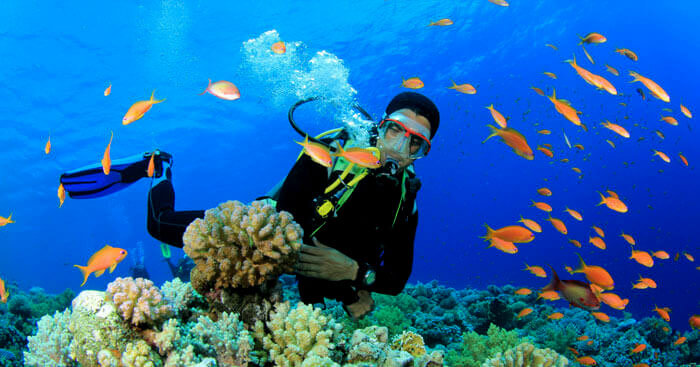Scuba diving is an experience like no other. There’s nothing like entering a whole new world full of adventure. A scuba diver’s life changes for the better, and before you know it, you have become an avid traveller with a bucket list of dive destinations that you have yet to visit.
BEST DIVE SPOTS
Where are some of the best dive sites? Here are five of my favorite diving destinations around the world.
1. THISTLEGORM, RED SEA, EGYPT
Egypt’s Red Sea is full of incredible scuba dive sites. However, Thistlegorm must be one of the world’s best diving sites. This dive site includes a large shipwreck, which requires many dives in order to do it justice. It’s best to go out with a dive centre that focuses around the wreck for two to three dives so that you get the most out of this top diving experience.
The SS Thistlegorm (translated as Blue Thistle) was a British Navy ship that was attacked from the air and sunk in 1941. At the time, she was carrying war supplies including ammunition, rifles, train carriages, motorbikes and large vehicles, all of which can be seen on this dive.
Make sure when you go that you have an advanced diving qualification, as the currents in this area can be quite strong and can also change direction in the blink of an eye.
2. RICHELIEU ROCK, THAILAND
When diving in Thailand, it’s pretty hard to find a dive site that is not a top spot, however after narrowing it down, Richelieu Rock is a ‘must-visit’ site. It consists of a horseshoe shape of rocky pinnacles that can be seen breaking the surface when the water is at low tide.
If you’re a diver hoping to see large mammals, then this is the place to be, as it is known for its whale sightings, as well as sharks, schools of huge pelagics, frog fish, jacks, barracuda and so much more.
Richelieu Rock is a great dive spot to experience from a liveaboard, as it requires more than one dive to really see its sheer beauty.
3. GREAT BLUE HOLE, BELIZE
This epic dive site is literally a large, deep hole, which is outlined by a coral reef and is home to a number of different species of sharks. There is nothing quite like diving at this fascinating landmark. Visibility at the Great Blue Hole stretches to 30m at this location, and dives start in the warm, almost bathwater-temperature shallows of the reef, which is covered in vibrant colours. As you descend down into the depths of the hoe, the water begins to shimmer as you transition from saltwater into freshwater at around 15m below the surface.
Giant tuna can be found here at various cleaning stations, as well as other large pelagics. Once you reach 30m, you get to observe the stalagmites and stalactites of ancient caverns. This really is an incredible dive site that should not be missed.
4. THE LIBERTY, INDONESIA
If you’re a budding underwater photographer, then this dive site is for you. Loved by photographers, which comes as no surprise, this fascinating wreck is totally encrusted with corals, anemones and gorgonians. The black sand underneath provides the perfect contrast of the sheer colour of marine life and coral that is in the area. It almost creates a blank canvas for nature to paint on.
At the Liberty, you’ll find huge schools of big-eyed trevally, as well as more than 400 species of fish. These fish are usually pretty tame, as over the years dive guides would feed them, so don’t be surprised if you catch a goatfish or wrasse nibbling at your fins.
The Liberty wreck dive is another dive that you may want to experience more than once, as it would be impossible to see everything there is to see during one dive. Consider trying a liveaboard trip, where you can stay in the area for a few days and get to experience all that the Indonesian waters have to offer.
5. THE YONGALA, AUSTRALIA
The Yongala is a shipwreck site located off the coast of Queensland. It is absolutely teaming with life, including manta rays, octopi, bull sharks, tiger sharks, turtles and so much more. Sadly, the SS Yongala sank as the result of a cyclone in 1911, killing 122 people. In 1981, it was given full protection under the Historic Shipwrecks Act. It stretches for 109m in length and is covered in spectacularly colourful corals. Don’t miss this dive in Australia.
